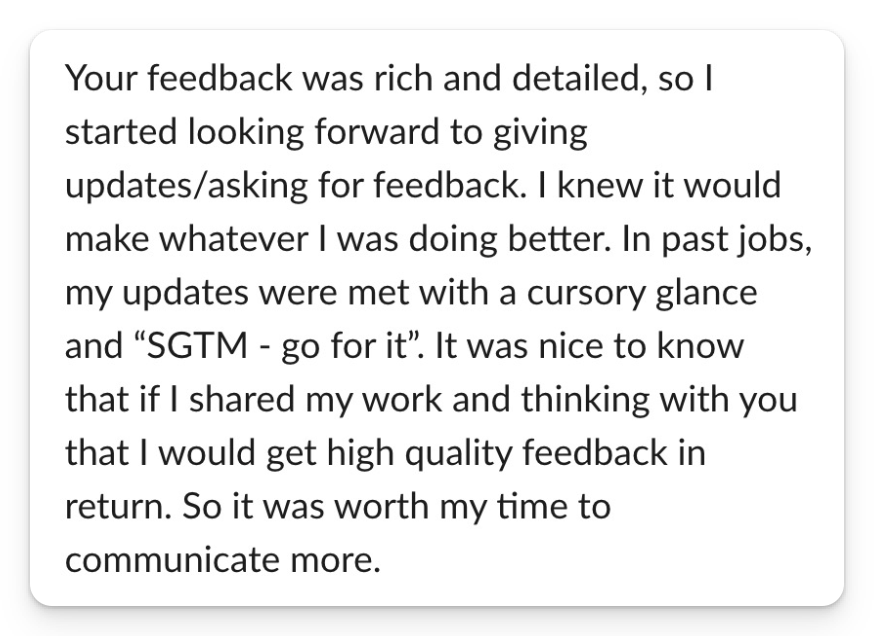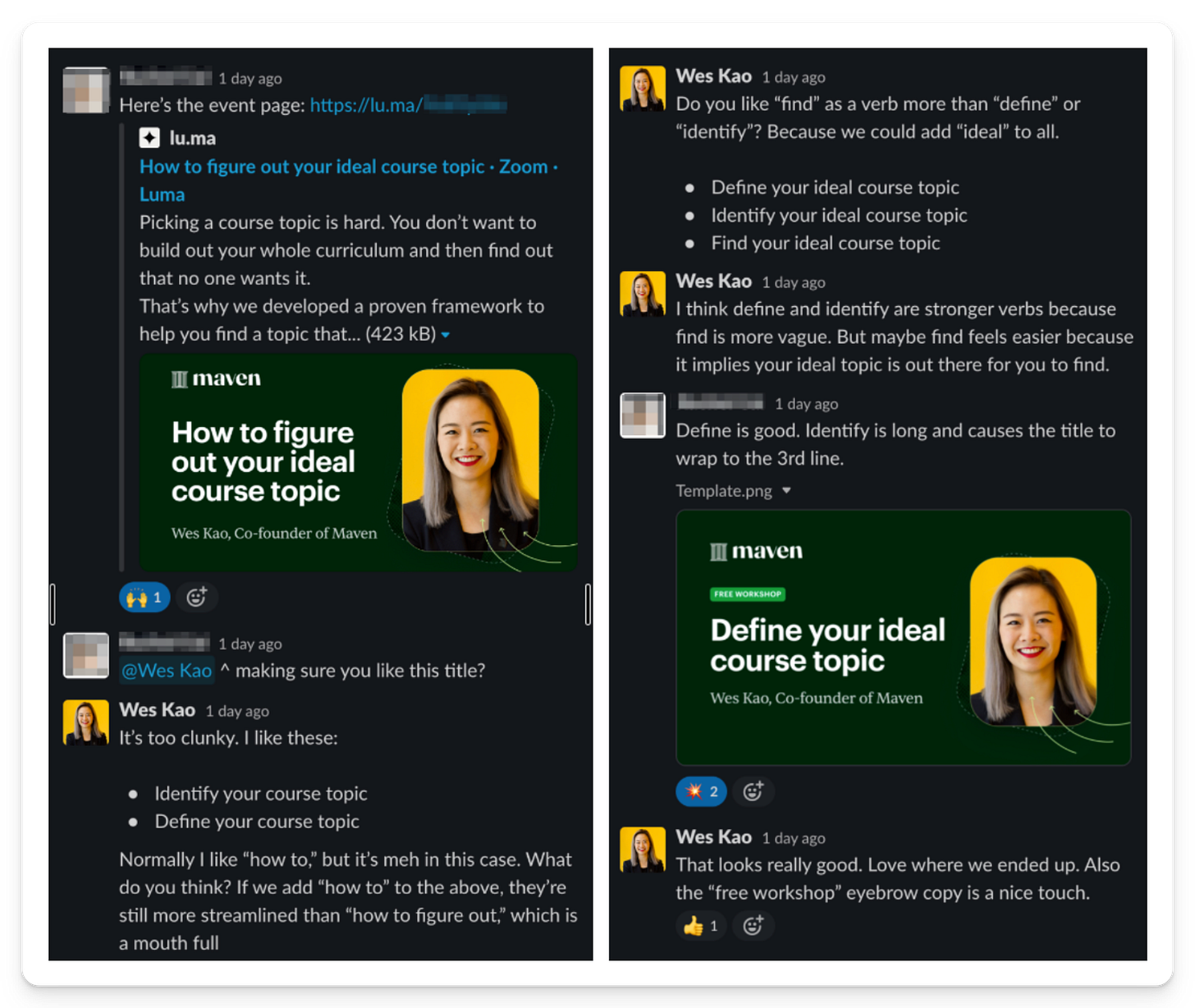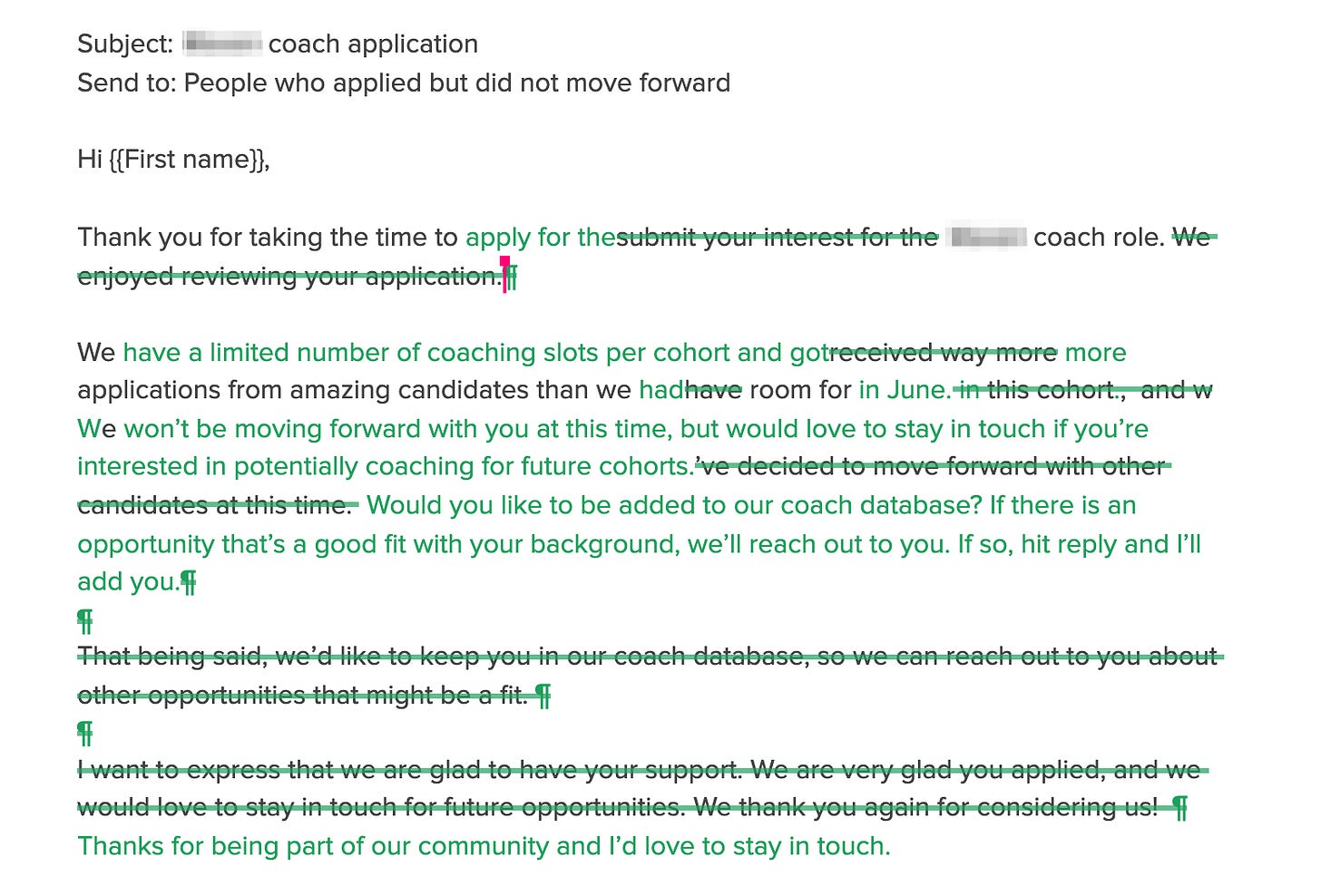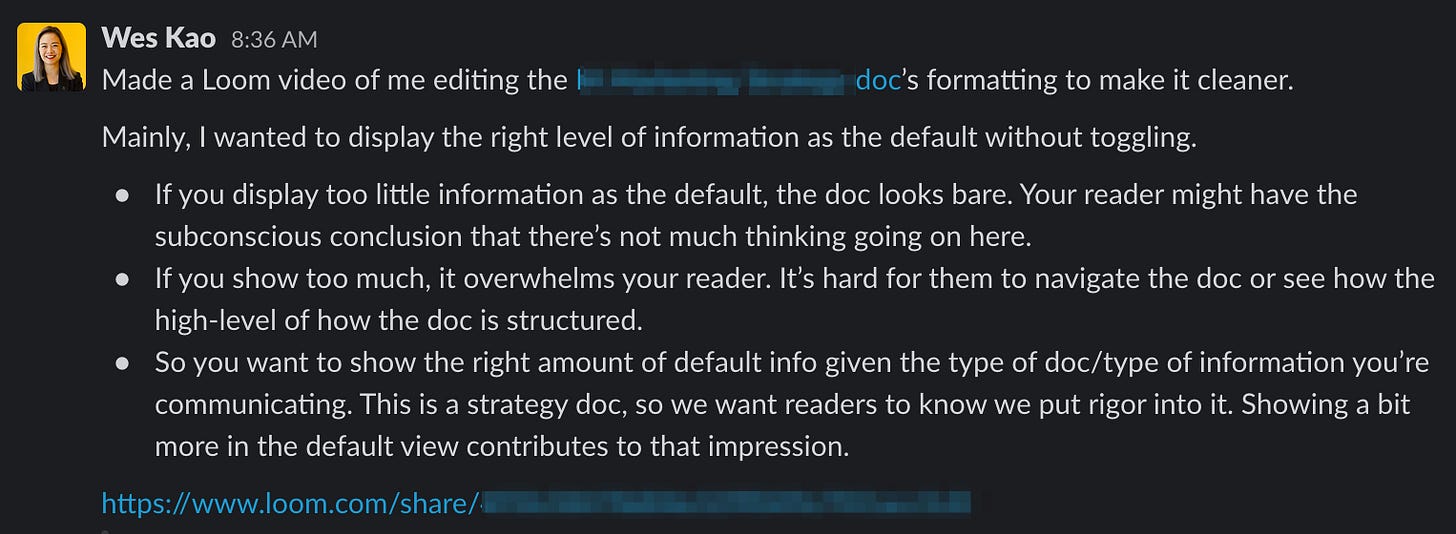Super Specific Feedback: How to give actionable feedback on work output
"Ninety minutes of your time can enhance the quality of your subordinate's work for two weeks, or for some eighty-plus hours." - Andy Grove, CEO of Intel
👋 Hey, it’s Wes. Welcome to my weekly newsletter where I share frameworks for becoming a sharper operator, rooted in my experience as an a16z-backed founder.
⛑️ Apply to work with me 1:1 for executive coaching, or bring me on as a keynote speaker on managing up, rigorous thinking, and creating a culture of direct feedback. Hit reply or fill out this form to see if we’re a fit.
This week, we’ll dive into how to give detailed and actionable feedback on work output.
Get “permission” and sell why getting lots of feedback benefits them.
Explain the “why.”
Avoid the shit sandwich.
Share positive feedback.
Aim for being tactical, actionable, concrete, and specific (TACS).
Structural feedback first, line edits second.
“I believe you were trying to do x, and if so, this part fell flat because y.”
Anytime you’re diagnosing, share what you noticed.
Use suggested edits.
Show a before and after.
Use comments.
Develop shared language.
Annotate screenshots for anything visual.
Mention if your feedback is stylistic or a pet peeve.
Record a screen share video or voice memo.
Balance what’s easy for you (feedback giver) and easy for them (feedback receiver).
Read time: 12 minutes
It’s extremely valuable to be a player-coach. A player-coach is a leader who can actually do the job, not just shout instructions from the sidelines.
If this is you, there’s one thing you must do, with no excuses: Coach your team daily.
Every piece of work product is an opportunity to share what you notice and to level up your team’s judgment. This allows you to help your team think like you, which acts as a force multiplier and passes on your capacity.
Giving detailed feedback on work output takes time, and it’s time well spent. There are some things you simply can't outsource.
This is one of them.
Part I: What is Super Specific Feedback?
The difference between general feedback vs Super Specific Feedback
When you hear “feedback,” you probably think of macro, behavioral feedback. This is the kind of feedback you’d include in a performance review. For example, “I noticed you missed the deadlines you set for these project milestones. I’d like to work with you on time management to make sure you’re not over-committed and prioritizing well.”
This is useful, but 90% of advice about feedback is about this.
Instead, I want to focus on a subcategory of feedback that’s less discussed: I call it Super Specific Feedback (SSF).
Regular feedback tends to be general, abstract, and mainly about behavior.
Super Specific Feedback is extremely concrete feedback primarily on work output, such as writing, product flows, marketing assets, and design. The goal is to strengthen the work product to get it closer to ship ready, and to help the feedback recipient improve their craft and judgment over time.
This type is important for a few reasons:
First, work output is the final form of thinking. Upstream, there’s strategy and intention. Downstream, the thing that customers eventually interact with is pixels and words. You’re not “just” giving feedback on an asset (like an email, job description, event image, website messaging). By giving feedback on the work product, you’re giving feedback on the strategic thinking that went into that asset. Why? Your customer doesn’t interact with your strategy as an abstract concept. No one cares what your intentions are. They care about what’s in front of them. They interact with your brand via words and pixels, in the form of product flows, copy, messaging, design, etc.
Second, you can’t teach judgment in a silo. Many people agree on a high level, but when they try to execute, they fail. They intended to do X, but the result looks nothing like X because there were too many subpar micro-decisions that compounded along the way. Super Specific Feedback on work output helps narrow the gap between strategy and execution.
Third, pointing out subpar work and offering coaching will raise the standard of excellence. Folks realize you won’t simply let things slide. It shows you care about doing work you’re proud of and want to push your team to be proud of their work too. I love this quote from ServiceNow CEO Frank Slootman:
“There is performance upside everywhere. As a leader, your opportunity is to reset in each of these dimensions. You do it in every single conversation, meeting, and encounter. You look for and exploit every single opportunity to step up the pace, expect a higher quality outcome, and narrow the plane of attack. Then, you relentlessly follow up and prosecute at every turn. Yes, it is confrontational. That is pretty much what CEOs do all the time: confront people, issues and situations. It’s not a quick transformation. In fact, it never ends.”
Super Specific Feedback is a way to “confront” and seize opportunities to improve the quality of work product.
What are the benefits of Super Specific Feedback?
For team members, most high performers crave more feedback and coaching from their managers, especially if their manager is someone they respect. Time and time again, I’ve seen high performers’ eyes light up when they get detailed, actionable coaching on work output. The result is more motivation AND improved judgment.
For managers, it frees up your bandwidth in the long run. You’re no longer the bottleneck. You’re no longer solely responsible for editing. You’re no longer the only one with high standards. Your team comes to you with work that’s in a tighter place to begin with.
The assertion behind SSF is:
By giving detailed feedback on work output, my team members will learn how I think and sharpen their own skills via hands-on concrete work.
This will lead to doing better work, faster, that requires fewer edits.
Over time, they will proactively address most or all of what I would have given them feedback on. My team members learn on the job, and feel challenged and supported.
Many leaders want to do kick off this virtuous cycle, but aren’t sure how to get started. Here’s how.
Part II: How to give Super Specific Feedback on work output
Here are 16 ways to give actionable feedback on work product starting today.
1. Get “permission” and sell why getting lots of feedback benefits them.
The right high-performers love getting feedback. I’ve had multiple direct reports say this was their favorite part of the job, and their months or years working together were the most they’ve ever learned. This is a huge gift you can offer your direct reports and it helps you retain high-performing talent.
One thing to note: If you haven’t been giving a lot of feedback and start to all of a sudden, folks might wonder where this is coming from. This is why you should get their buy-in: share why frequent feedback benefits them, why you’re investing time into coaching them, and making sure they’re excited about it.
Your direct reports should feel like your feedback is a gift you’re giving because you believe deeply in their potential.
2. Explain the “why.”
This is the root of all Super Specific Feedback. Don’t just say "This doesn't work." Share your explanation of the improvement that needs to be made, and also the bigger thinking behind the “why” and “how.” This includes solid analogies that help to reinforce and clarify the point. If there is one thing you take away from this post, let it be this. Explain the why behind your feedback.
For example, here’s feedback I shared with Maven’s branding agency when they were designing our logo. Notice how I didn’t only say “I don’t like this.”
Design is subjective, but by sharing your thought process, you can have more productive conversations and get closer to a strong outcome. It’s a meme that marketers say “make the button bigger!” and force their design counterparts to execute seemingly random changes. Don’t be that person. I’ve had great working relationships with designers for over a decade in large part due to sharing my strategy and thought process, then letting them decide how to express that visually.
3. Avoid the shit sandwich.
Be direct with both constructive and positive feedback. Below is an example of sharing feedback with a team member. Notice how I’m quite direct in saying, “this feels a bit uninspiring” and “it doesn’t seem like our best effort.”
This works because I share my specific examples and my process (see list item #1), but also because other times, I’ve given this person positive feedback when it was warranted. This is different from the shit sandwich, which is giving fake positive feedback on either ends of what you really want to say. It’s intellectually honest and rigorous to simply say what you want to say, as long as you support it with evidence, logic, and a respectful posture.
4. Share positive feedback so they know what to continue doing.
The ultimate goal for feedback is behavior change. You want to give positive feedback because you want them to continue doing what’s working. Otherwise, your direct report might accidentally stop doing something because they didn’t realize it was effective.
The other reason positive feedback matters is because it buys you goodwill, which allows you to be super direct with constructive feedback. My team knows that I give them positive feedback when it’s warranted, and celebrate not only the results, but also their effort, conscientiousness, rigor, etc. So when I have constructive feedback, I can be equally direct because I’ve established that I’m objective.
5. Aim to be tactical, actionable, concrete, and specific.
I originally wrote about the TACS framework for creating outward-facing content, but it applies to giving feedback too.
Tactical: “This isn’t a generic, hand-wavy theory.”
Actionable: “I can put this into practice right now and apply it to my future work.”
Concrete: “This can be observed and measured.”
Specific: “This is precise advice for a particular situation.”
In this example, we went from a clunkier event title to a cleaner one. My team member learned about the interplay between copy and design, being concise, using strong verbs, etc. If I had just shared these tips separately from this real-life example, it wouldn’t have hit as hard as learning it on the job, with this specific example of work product.
6. Structural feedback first, line edits second.
If what you get is far from what you expected, do not give line edits. Give structural feedback first. If you start giving line edits, you might trim entire paragraphs or chunks—or the premise and strategy itself could be off-base. Should we even be doing this at all? Should we do it in this way?
Give high-level structural feedback first, then have the person take another stab. Once they send something back, you can share another round of structural feedback or give line edits. Examples of structural feedback:
“This company-wide strategy doc should be inspiring, but it’s too dense and kind of dry. There’s not enough sign posting, so as a reader, I can’t tell where you’re going. For example, [insert before and after]. This doc would be a lot clearer if you applied that throughout. If you want to take another stab, I can review your updated draft.”
“This email is too much about logistics, not enough about sales. The prospect isn’t sold yet. We need to get them excited about this, then we can share details. Let’s have you take another stab with this in mind, then I can review.”
Notice how I didn’t give line edits. I gave one round of high-level feedback first, which can take as little as 5 minutes. This is better for me (saves my time) and better for them, because I’m breaking up the feedback into two steps. They get the right level of feedback at the right time.
7. Use this structure: “I believe you were trying to do x, and if so, this part fell flat because y. Consider trying z instead.”
When you say “I believe you were trying to do x,” you establish mutual understanding of what the person was trying to do. For example:
“I can see you were trying to get the customer excited, but it feels a bit forced and heavy-handed. We can’t just tell people to ‘be excited.’ I recommend taking another stab and being less on the nose. For example, build hype by sharing a few short customer quotes, name drop recent customers who just signed on this week, and share a story where the prospective customer can see themselves in the example.”
8. Anytime you’re diagnosing, share what you noticed.
A big chunk of a leader’s time is spent diagnosing situations on your team or around the company. If you’re already diagnosing, take the extra step to share what you notice and what you’re fixing. This doesn’t have to be intense or take hours—it could take just an extra few minutes. This is about noticing when you have insights.
Whenever you have an insight or think something could be better, get used to sharing it out loud. Your default might be to stifle the thought and move on, but change the default to sharing.
9. Use suggested edits in Google Docs.
This is a great way for your direct reports to see what you changed. I usually say “Study the edits, don’t just accept all of them quickly. Review each one and compare to what you had before so you learn from the edits.”
10. Use comments to explain your thought process.
If you’re not sure what the change should be, but know there’s something awkward about the work, add a comment and ask them to take another look. Or, use comments to ask a question or share your thinking behind an edit.
11. Show a before and after.
This is one of the most powerful ways to “show, not tell.” When you do a before and after, you show the difference between their version vs your version. This captures way more tacit information than describing the changes alone. It also shows "you've “still got it” as a leader because you were able to create a strong “after” yourself.
12. Develop shared language.
Some examples of shared language I have with my team are too much cognitive load, too me-focused, about customer vs to customer, too spammy, don’t incept negative ideas, etc. Those phrases might not make sense to you, but that’s the point: It made sense to my team internally. You can develop the same shared language with your team.
Speaking in shorthand is pretty amazing. You can say a few words—and your team will immediately know what you mean, and vice versa. When you’ve built up context from previous feedback conversations, you can move much faster with less communication overhead.
13. Annotate screenshots for anything visual.
It’s much easier to share feedback with an annotated screenshot than trying to describe via words alone. This is especially helpful for giving feedback on marketing assets, product flows, and UX.
14. Record a screen share video or voice memo.
It might take 30 minutes to draft written feedback but only 3 minutes to speak out loud. Fun fact: many Maven employees are in the top 10-15% of Loom users. One employee is in the top 3% of Loom users. We have an intentionally asynchronous company culture, so tools like this are super helpful for sharing high-fidelity feedback & allowing recipients to review when it’s convenient for them.
The benefit of written feedback is it can be copied/saved and shared more broadly in your organization. But the downside is you need to be a clear thinker to do this, and let’s be real, you don’t always have time to form super clear thoughts. As Paul Graham says, “Writing about something, even something you know well, usually shows you that you didn’t know it as well as you thought.”
Luckily, you can speak out loud and your team will probably get the gist of what you’re saying. The benefit of Loom is you can point to what’s on the screen, scroll, and talk as you go. You can pull on more levers (voiceover, visuals, text on screen, motion) that help to convey meaning.
15. Mention if your feedback is stylistic or a pet peeve.
There’s a difference between something that’s incorrect or breaking generally accepted conventions vs something you personally dislike. I actually think both are equally valid. You just want to be clear which is which.
For example, I dislike the word “wanna,” but the word isn’t always bad. Many marketers use it, but I believe there are better words for sounding conversational.
There are often different schools of thought on an issue. You can ask ten different founders, and they might have ten different views on a thing. You may be in one camp, and you may be disproportionately bothered by a thing. Being explicit about this helps your team understand the range of viewpoints, and how to make an informed decision for themselves.
16. Balance what’s easy for you (feedback giver) and easy for them (feedback receiver).
You want to make feedback easy for your recipient to take action on, but if you want to give SSF in the long run, you need to do it in a way without burning yourself out.
Your direct reports would rather have you give feedback in the format you prefer (example: voice memos, Loom videos instead of written feedback) than not get any at all. Let them know if you prefer a certain medium so they know why you’re sharing in that medium, and make sure they find that medium helpful too.
I used simpler examples above because most of the feedback I’ve given on product, UX, messaging, emails, etc would need to be too redacted for it to make sense. But the principles and tactics above apply to a variety of work output.
While I wrote from the perspective of a leader giving feedback to their team, this works equally well for folks giving feedback to peers. My team would often give each other very high quality feedback.
When you model Super Specific Feedback, and your team sees how you do it, they can then do it themselves and for each other. You unlock a whole new level of leverage (and motivation) when your team can learn from you and each other.
I’d love to get your help growing our community of thoughtful, rigorous operators. If you enjoyed this post, consider taking a moment to refer a friend to unlock my favorite book recommendations for free.
Thanks for being here, and I’ll see you next Wednesday at 8am ET.
Wes
PS If you’re ready to level up, here are more ways I can help:
Follow me on Twitter or LinkedIn for bite-sized tips throughout the week (free).
Book me as a keynote speaker to inspire and level up your team.
Reach 35,000+ high-performers in tech by sponsoring this newsletter.
Work with me for 1:1 executive coaching. Hit reply or fill out the form.
While you’re here, check out these other essays:





















Thank you for sharing your examples. So helpful! This is going to sound gushy but I wish you were my manager 😂
Amazing read! So many great ideas on how to handle feedback better. I love TACS.